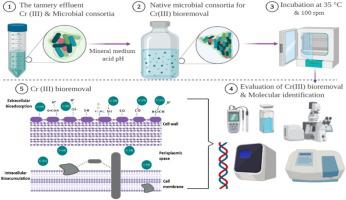Journal of Environmental Chemical Engineering ( IF 7.7 ) Pub Date : 2020-10-18 , DOI: 10.1016/j.jece.2020.104626 Brandon Reyes-Romero , Adriana N. Gutiérrez-López , Raúl Hernández-Altamirano , Violeta Y. Mena-Cervantes , Estela Ruiz-Baca , Elier E. Neri-Torres , Isaac Chairez , Selene M. García-Solares , Jorge Vazquez-Arenas

|
Microbial consortia are isolated and enriched in discontinuous reactors under anaerobic conditions using different stoichiometric ratios of acetate (substrate): Cr(III) concentration: reactors A (0.5:1), B (1:1) and C (2:1). The inoculum is stemmed from a tannery effluent with the aim of tolerating and eliminating high concentrations of Cr(III) (2760 mg L−1). The Cr(III) removal process is performed in two stages for each reactor. Stage I is an abiotic process involving the reaction between acetate and Cr(III) forming the complex , which on its turn precipitates as in the first five days, thus, decreasing the metal concentration by 24, 42 and 61 % for reactors A, B and C respectively. FT-IR analysis, SEM-EDX, biomass and extracellular polymeric substances (EPS) indicate that the native bacteria enriched in the reactors eliminate Cr (III) during the biotic stage via bioadsorption and bioaccumulation mechanisms. Reactor C achieved the lowest Cr(III) concentration around 600 mg L-1 (78 % removal). The occurrence of these mechanisms was due to the nature of the inoculum since the bacteria were well adapted to the presence of high Cr(III) concentrations, whereby they did not require optimal growth conditions unlike a pure strain. The isolated strains were molecularly identified by amplification and sequencing of the 16 s rRNA gene using universal oligos 63 F (5’CAGGCCTAACACATGCAAGTC3′) and 1542R (5′AAGGAGGTGATCCAGCCGCA3′), finding a 99.06 % of similarity to Lactobacillus diolivorans (strain JCM 12183 accession number LC311745.1), and 99.88 % similarity to Lactobacillus brevis (strain C23 accession number MN880215.1). SEM-EDX enables to identify that the consortia are mainly composed of bacilli undergoing pleomorphism, due to the complex formations between functional groups in the cell wall and Cr(III).
中文翻译:

使用非生物和厌氧工艺与天然微生物联合体去除制革厂废水中的浓铬(III)
使用不同化学计量比的乙酸盐(底物):Cr(III)浓度:反应器A(0.5:1),B(1:1)和C(2:1),在厌氧条件下在不连续的反应器中分离并富集微生物群落。接种物来自制革厂废水,目的是耐受和消除高浓度的Cr(III)(2760 mg L -1)。对于每个反应器,Cr(III)的去除过程分两个阶段进行。第一阶段是一个非生物过程,涉及乙酸盐和三价铬(Cr)之间的反应,形成络合物,依次沉淀为 因此,在前五天内,反应器A,B和C的金属浓度分别降低了24%,42%和61%。FT-IR分析,SEM-EDX,生物量和细胞外聚合物质(EPS)表明,在生物阶段,反应器中富集的天然细菌通过生物吸附和生物蓄积机制消除了Cr(III)。反应器C达到最低的Cr(III)浓度,约为600 mg L -1(78%去除率)。这些机制的出现是由于接种物的性质,因为细菌很好地适应了高Cr(III)浓度的存在,因此与纯菌株不同,它们不需要最佳的生长条件。使用通用寡核苷酸63 F(5'CAGGCCTAACACATGCAAGTC3')和1542R(5'AAGGAGGTGATCCAGCCGCA3')对16 s rRNA基因进行扩增和测序,对分离出的菌株进行了分子鉴定,发现与甘蔗乳杆菌(JCM 12183保藏号)的相似性为99.06%。编号LC311745.1)和与短乳杆菌的99.88%相似性(菌株C23登录号MN880215.1)。SEM-EDX能够确定该财团主要由经历多形性的细菌组成,这是由于细胞壁中的功能基团与Cr(III)之间形成了复杂的结构。



























 京公网安备 11010802027423号
京公网安备 11010802027423号